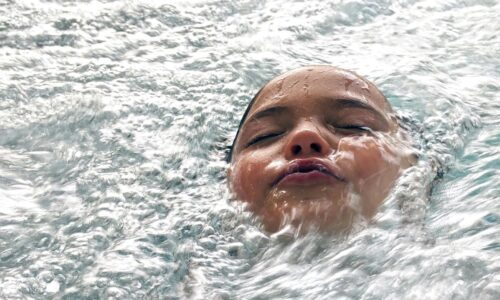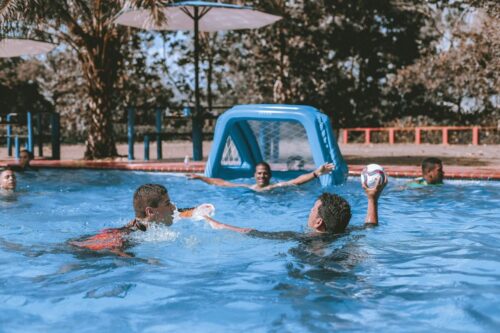Silent Death: Why Autism Increases Risk of Accidental Drowning
 For parents and caregivers of children as well as adults on the autism spectrum, summertime is often filled with water activities as a refreshing way to escape the heat and have fun at the same time. Whether it’s headed to a neighborhood or community pool, splashing around at spray parks, or hanging out at an area lake or beach, it’s one of the season’s favorite pastimes. Unfortunately, water activities, including bathing, carry significant risks for autistics.
For parents and caregivers of children as well as adults on the autism spectrum, summertime is often filled with water activities as a refreshing way to escape the heat and have fun at the same time. Whether it’s headed to a neighborhood or community pool, splashing around at spray parks, or hanging out at an area lake or beach, it’s one of the season’s favorite pastimes. Unfortunately, water activities, including bathing, carry significant risks for autistics.
According to several studies, individuals with autism spectrum disorder (ASD) face an increased and staggering risk of accidental drowning compared to the general population. According to several research studies, including findings from Columbia University’s Mailman School of Public Health, children with ASD are estimated to be anywhere from 160 times to nearly 200 times more likely to be a drowning victim of accidental drowning than other children.
The Columbia study goes on to cite that accidental drowning is the No. 1 cause of death for autistic children. It’s also the leading cause of the silent death in children overall ages 1-4. These devastating statistics underscore the critical importance of constant supervision around any body of water and the urgent need for effective water safety skills and interventions for autistics at any age.
Learning how to swim is an important life skill to learn, especially since the vast majority of the world is water. Plus, if one small pool of water is enough to result in drowning, that’s a pretty big risk in your everyday life. My mom had me in swim lessons before I was 5 years old, after I fell into a neighbor’s pool one time at a backyard party. Although she immediately jumped in and fetched me out, she said it was shocking how quickly and quietly the incident happened (and luckily for me, she was closely watching).
She said I immediately took to swimming, and was very good at it, to the point where I became a certified lifeguard at age 16. Since then, I’ve shockingly learned less than half of people in the world know how to swim (44 percent, to be exact) and could very well be the next accidental drowning victim as a result. So, regardless of your abilities, learning water safety, which hopefully includes learning how to swim, is essential.
Why Are Autistics at Higher Risk of Being A Drowning Victim?
Several key factors contribute to the elevated drowning risks for those on the autism spectrum:
Wandering/Elopement Behavior
One of the primary risk factors is wandering or elopement behavior common in many autistics. Individuals of all ages with ASD often have an innate desire to seek out enclosed spaces or explore new areas that pique their curiosity or sensory interests. They may wander away from a supervised setting like their home, school, or other controlled environments.
If they find their way to a pool, pond, lake, river, or ocean while unsupervised, it could very quickly become a life-threatening situation due to accidental drowning risks.
Lack of Understanding of Danger
Some autistic children and adults may not fully comprehend or recognize the dangers associated with being in or near bodies of water without supervision and safety precautions. A lack of understanding about potential drowning hazards combined with wandering tendencies can rapidly escalate into an emergency scenario.
The strong desire to explore their surroundings can tragically override any sense of instinctual caution around water sources. Additionally, some nonverbal or minimally verbal autistic individuals may not be able to communicate about being in distress around water until it’s too late.
Attracted to Water and Its Sensory Input
Intriguingly, research indicates that some individuals with ASD spectrum disorders seem to be inherently drawn to bodies of water and the sensory experiences they provide through unique lights, sounds, textures, and other sensory inputs. This sensory fascination with water can override any fear or cognitive understanding of water risks.
Playing with and exploring water’s sensory properties like reflections, currents, and temperatures may be reinforcing in a way that outweighs perceived dangers in the mind of the autistic child or adult. The pursuit of this sensory interest can lead to wandering away and potential drowning perils.
Difficulty with Swimming and Water Safety Skills
Coupled with other risk factors, many autistic children and adults struggle to learn appropriate swimming and water survival skills due to challenges with motor skills, sensory processing issues, communication deficits, fears or aversions, and difficulties with following instructions.
Important water and swimming pool safety skills like floating, treading water, and other crucial techniques may not be effectively learned or retained, decreasing the ability to respond safely if they end up in the water unexpectedly. Accidental drowning can happen to anyone, and typically occurs in seconds and is often silent. That’s why it is sometimes referred to as a silent death.
With these multiple risk factors converging, parents, caregivers, teachers, and loved ones need to exercise hyper-vigilance around any potential water hazards for autistic children and adults.
Tips for Accidental Drowning Prevention
Drowning prevention should incorporate multiple layers of protection and precautions:
Swimming Lessons and Water Safety Training
One of the most important steps is pursuing swimming lessons and water safety training from certified instructors who have experience teaching individuals on the autism spectrum. While it can certainly be challenging, instruction tailored to the unique needs of autistic students can help teach critical skills. Visual aids, repetitive practice, and exploring a variety of teaching methods can boost skill acquisition. Don’t give up if initial attempts are difficult – lives may depend on persistence.
Safety Gear & Pool Fencing
Investing in high-quality safety gear is essential, such as life jackets and other U.S. Coast Guard approved personal flotation devices (PFDs). Specialty PFDs designed for increased head support may be worthy considerations as well. Around residential pools, safety pool fencing certified by safety organizations should be installed to restrict unintended access.
Constant Supervision Can Avoid the Silent Death of Drowning
Perhaps most important is the absolute necessity of constant supervision anytime an autistic individual is around any body of water – including bathtubs, pools, ponds, lakes, and more. Caregivers must maintain a resolute dedication to visual monitoring and remain within arm’s reach at all times with no lapses in attention. The saying “It only takes a second” has a tragic truth – supervision can never be sacrificed around water sources. Summertime swimming pool safety tips must also be utilized at all times.
Alarms/Monitoring Devices
While not replacements for visual monitoring, specialty door and window alarms can provide an extra layer of protection with water and swimming pool safety to indicate if an autistic child or adult has wandered out of an intended safe space. Wearable GPS tracking devices can also aid in locating individuals if dangerous wandering incidents occur.
With comprehensive precautions in place encompassing training, gear, supervision, and monitoring – we can help protect our loved ones with ASD and autism against the perils of drowning situations. However, constant vigilance is paramount, as the risks and consequences are so high.
React Immediately to Wandering
Caregivers should also have a safety action plan in mind for how to respond if wandering or unexpected water access ever does occur. Initiating an immediate search, notifying emergency personnel right away, and being prepared with rescue measures could mean the difference between life and death. Every second counts in preventing drowning tragedies. Rehearsing rescue response plans may seem difficult but is wise preparation.
Be Hyper-Alert During Warmers Months
As warmer spring and summer months arrive, autism families and caregivers must increase their water safety awareness and practices. More time spent outdoors increases the chances of children and adults wandering into pools, ponds, lakes, or other bodies of water while pursuing their interests and curiosities. Renew swimming lesson focuses, inspect all safety equipment, and redouble supervision practices as temperatures rise.
Advocate for Autism Water Safety and Avoiding Silent Death of Drowning
Finally, all members of the autism community should be fierce advocates for increased water safety education, training opportunities, and prevention initiatives that cater to the specific needs and risks of autistic individuals.
Push for better safety standards, more research, and further resources to enhance safety skills and awareness. Many of these heartbreaking drowning incidents could be avoided with comprehensive planning and a united commitment to protecting our loved ones.
Accidental Drowning Intervention Research & Training
While the dangers of drowning for those with autism are clear, there is still much work to be done in developing more robust research, training programs, and interventions to address these critical safety issues. Fortunately, some organizations are prioritizing drowning prevention and swimming pool safety for the autism community.

The association has promoted legislation like the Kevin and Avonte Law to provide tracking resources for children with autism who may be at risk of wandering into unsafe situations.
On the research front, studies are examining areas like fatal and non-fatal drowning incidents in people with autism, their experiences in swimming programs, the use of life jackets and other flotation gear, wandering patterns, decision-making skills around bodies of water, and especially swimming pool safety, and potential interventions.
While the statistics are stark, some positive findings indicate that skills like swimming and safety awareness can be developed in many autistic children and adults given appropriate, patient, and tailored instruction. Visual teaching methods, applied behavior analysis, conditioning techniques, and identifying motivators are some of the approaches showing promise within case studies and small sample research projects.
With a comprehensive, multi-faceted approach – we can turn the tide against autistic accidental drowning incidents by promoting deeper awareness, enhancing safety skills, increasing supervision vigilance, and catalyzing further research and innovations. It must be an all-hands-on-deck mindset where every contribution leads to creating solutions to protect anyone in the autism community (and in general) from being an unintentional drowning victim.
Additional Challenges Individuals with Autism Face
Learn more about other issues that autistics face:
- Being Real Without Offending Others is an Autistic Challenge
- Indecisiveness and Autism: How These 6 Factors Impact Decision Making
- Helpful Self-Regulation Tips for Keeping Calm and Carrying On
- Is Autism a Disability? Surprising Reasons for the Debate
- Social Justice Issues: Why Disability Rights Matter for Autistics
- Break Free: 10 Tips to Take A Risk and Escape Your Comfort Zone
- 6 Fascinating Facts About Autism You Probably Didn’t Know
- 8 Popular Ways to Manage and Master Autistic Social Awkwardness
- Autism and Poor Hygiene: The Smelly Truth to Overcome
- Breaking Down Barriers that Challenge Autism and Friendships
- Anxiety and Autism: 5 Powerful Strategies to Conquer Emotions
